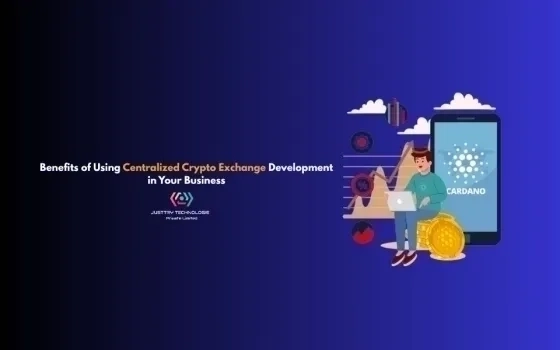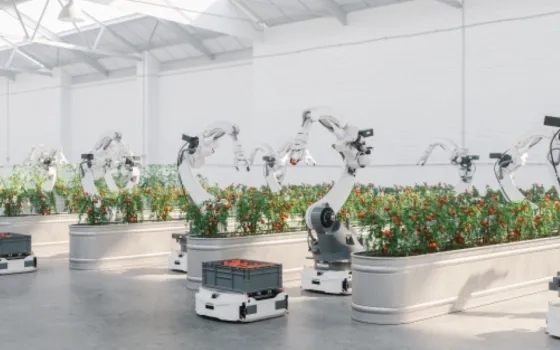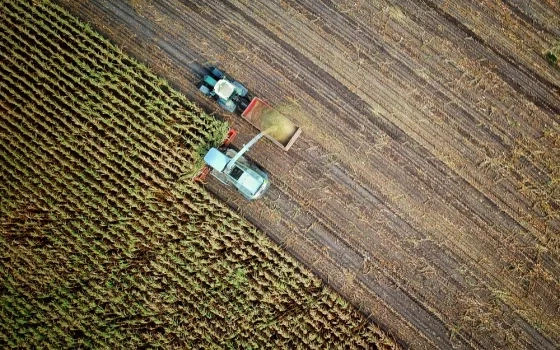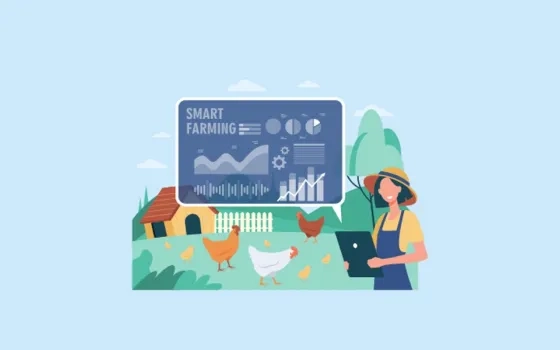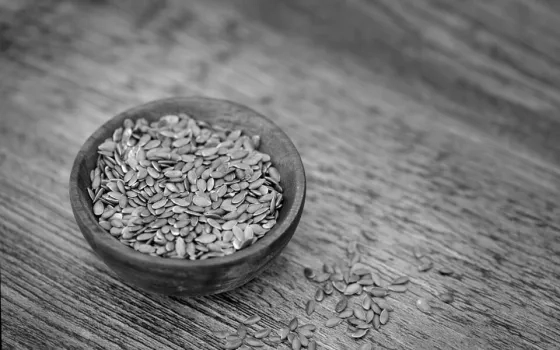The share of agriculture to be $1 trillion when India’s economy touches $5 trillion in 2025. – PM Narendra Modi at World Economic Forum Annual Meeting in Davos
India has been at the forefront of advances in the agriculture in the world. Government policies in the field of water & soil conservation, animal husbandry, irrigation and research & extension services have led India to emerge as amongst the fastest growing agriculture economy since 2002. Today, agriculture contributes nearly 17.5% of India’s GDP. Since 2002 India has seen 3% annual growth rate in the agricultural sector. But a lot needs to be done to fulfil the government’s vision of making Agriculture add one trillion dollars to the economy.
Current Agriculture Scenario
India is the world’s largest producer of many fresh fruits and vegetables, milk, major spices, select fibrous crops such as jute, staples such as millets and castor oil seed. India is the second largest producer of wheat and rice, the world’s major food staples. Aquaculture and catch fishery is amongst the fastest growing industries in India. Total area in India, sown with Rabi crops reached 64.29 million hectares in February 2018.
India’s production of food grains has been increasing every year, and India is among the top producers of several crops such as wheat, rice, pulses, sugarcane and cotton. It is the highest producer of milk and second highest producer of fruits and vegetables. In 2013, India contributed 25% to the world’s pulses production, the highest for any one country, 22% to the rice production and 13% to the wheat production. It also accounted for about 25% of the total quantity of cotton produced, besides being the second highest exporter of cotton for the past several years. Major commodities exported by India are rice, spices, cotton, meat and its preparations, sugar, etc.
Total operational landholders in India possess the cultivable land with an average of 1.5 ha. per landholder. Out of total landholders, there are 93 million marginal farmers, 25 million small farmers, 20 million medium farmers & 1 million large farmers. (Source: Agriculture Census, 2010-11).
Challenges of Present and Future
While India has immerged as the nation which has been ahead of its peers in agriculture, however, the country has lots of challenges which need to be addressed. The climate change which is leading to substantial reduction in water availability, non-adoption of Good Agriculture Practices, continuous increase in tolerance of pests to crop protection measures, substantial decrease in quality of soil due to unsustainable farming, stress on realization from produce due to low international commodity prices, labour shortage because of migration from rural to urban/sub-urban by masses and access to viable credit & risk mitigation tools are key issues faced by farmers in India.
Some of the challenges faced by the farmers in India due to above-mentioned issues include access to irrigation, the high cost of mechanization & shortfall of labour, decrease in productivity & profitability of farmers in most crops, reduction in total cultivated land & average land holding, and continuous increase in the cost of cultivation.
Today farmers of India are faced with unprecedented problems including
Identification of Correct Crop, Variety and Quality Seeds
What to sow is a key issue as farmers are oblivious to the substantial change in climate, soil characteristics, and agriculture economics. Traditional crops, grown season after season, without the use of modern agriculture practices has led to low-productivity. Another allied issue is selection, access and affordability of quality seeds. Further, the perception based decisions and resistance to change in cropping pattern have led to increased pest problems leading to substantial crop failures over last few years.
Application of Quality, Relevant and Genuine Agriculture Inputs
The farmers do not have precise information about when, where and how to apply crop nutrients and crop protection to their crop based on their land and historic cultivation pattern. The penetration of spurious, low quality and illegal agriculture inputs are not only creating problems to farmers but are also leading to compromise of the health of those who are consuming the cultivated food. High residue due to unsustainable use of crop protection and crop nutrition products is leading to both cost escalation as well as food contamination along with an increase in soil, air and water pollution.
Access to Irrigation and Unsustainable Water Use
Availability of Irrigation to Indian’s farmers is very less. Further, reduction in throughput from rivers and climate change leading to the imbalance in rainfall is making condition worst. Majority of farmers are dependable on rain for their crops’ cultivation and at the same time farming practices are heavy on the use of water in an unsustainable manner. High usage of water per ton for most crops has created a huge mismatch between water availability and water requirement.
Availability of Labour and Lack of Viable Farm Mechanization
Non-availability of affordable labour is one of the major issues for Indian’s farmers. As labour in agriculture is seasonal, it is leading to a lot of dependence on migratory labour which is further leading to inconsistent and inflexible farm labour market. This is impacting heavily the on-field activities being done, required for quality output with higher productivity. Also, the farmers are unaware of the latest machinery which can be used for land preparation, sowing, irrigation, harvesting, thrashing, mulching, pruning, weeding etc. Further, the low average landholding and a high number of smallholder/marginal farmers makes the farm mechanization unviable.
The Last Mile Connect with Agricultural Markets
The biggest issue with the farmers currently is that they do not get the viable price for their harvest. Many times it has been seen that the price they get is below Minimum Support Price (MSP) while most of the other crops (spices, horticulture etc.) do not even have MSP. Many times they do not even know about the MSP and also because of that, there is no information/recommendation about which crop will be price wise beneficial at the time of harvest. Middlemen are playing a dubious role because of which our farmers are not able to get the correct price of their harvest.
Unorganized Credit and Lack of effective Risk Mitigation
While government and financial institutions have made available various schemes and products to help farmers yet the on ground last mile access is creating a limitation in reach as well as delivery. The farmers are forced to take credit from the unorganized market at high rates which are unaffordable leading to a debt trap. Further, most of the products are suited for farmers with high land holding putting smallholder/marginal farmers in the position of disadvantage. Risk mitigation products and policies are difficult to implement due to challenges faced on the ground. Lack of efficient and effective crop insurance tools are impacting smallholders in a big way as the crop failure leads to not only huge losses but to avail any relief is complex and time-consuming.
Lack of Actionable Information and Insights
Farmers are not aware of how to stop the damage to their land and its nutrients due to factors like water and wind. They do not have know-how about how to store, pack their harvest and what to use for that.
There is a lack of actionable insights to the farmers about the pests, diseases and also at what time they can attack a particular crop and appropriate interventions to safeguard their crops.
Impactful Agriculture Technologies
Farmers in India are plagued with low productivity, unavailability of relevant quality agriculture inputs, poor market linkages, less or no access to credit, and scattered information of good agricultural practices, commodity pricing trends, local weather, soil, and pests. These problems need to be addressed if we want to “Double the Income of Farmers” in the next five years. Key to solving these challenges is the use of Agriculture Technology.
Three key areas of technology which can be pivotal in solving long-standing challenges of farmers include, Plant Science (including Bio-Technology and Nano Technology), Farm Automation (including Internet of Things and Precision Agriculture using Autonomous Arial and Ground Vehicles), and Informatics (including Data Science, Artificial Intelligence, and Machine Learning)
Plant Science
Plant science techniques like Plant Breeding, Genetically Modified Organism (GMO), Tissue Culture, Aquaponics & Hydroponics and Bio-Technology (Bio Fertilizers, Bio Pesticides, etc.) can, not only increase the yield & productivity of the crops but also ensure farming is done in a sustainable manner reducing residue of harmful chemicals in the harvested output. These practices will reduce dependence on harmful chemical on one hand and reduce the use of water on the other.
Breeding is useful to develop new varieties of a crop from a single crop. Hybridization can also be useful for the evolution of new crops. With the help of cutting & budding, we can introduce the vegetative reproduction of the plants.
They help in resisting the crops from harmful chemicals and fertilizers. They are produced in laboratories by applying the practices of Breeding and Tissue Culture. They are resistant to the drought and can survive with high temperature and improper application of water.
Further GMO is used to produce a number of crop varieties from the single genome of the plant at less place which can give more yield and at the same time they are resistant to the diseases, can be grown without fertilizer and pesticide application and quickly produce mature plants.
Soilless plant science like Aquaponics and Hydroponics can be very effective in ensuring crops can be grown in a controlled environment close to its demand reducing cost and time of transportation. This leads to better economics as well as safer chemical-free food using less land, less water, less chemicals and lower loss during transportation.
Nanotechnology can be applied to study plant’s hormone levels and its regulations. Nano barcodes and Nano processing are useful in monitoring the quality of agriculture products as well as traceability. Carbon nanotubes are useful to detect and kill the pathogens and viruses in the crops. Nanoparticles mediated plant transformation has the potential for genetic modification of plants for further improvement. Specifically, application of Nanoparticles technology in plant pathology targets specific agricultural problems in plant-pathogen interactions and provide new ways for crop protection.
Farm Automation
Internet of Things (IoT) brings to the table many advantages, its ability to innovate the landscape of current farming methods is absolutely groundbreaking. IoT sensors capable of providing farmers with information about crop yields, rainfall, pest infestation, and soil nutrition are invaluable to production and offer precise data which can be used to improve farming techniques over time.
Farm Automation with the latest equipment is going to be very effective in reducing human efforts and precise way of doing various activities like land preparation, sowing, weeding, harvesting, spraying etc. Unmanned Arial and Ground Vehicles are impactful to change the way farming is being done as it can help farmers to use minimal labour to execute tasks as well as see the activities being done on the ground by these vehicles like drones for counting of plants, spraying fertilizers or pesticides, taking real-time plant growth images etc. And these data afterwards can be useful for the analysis and to pass on the real-time information to the farmers from farm level without going to the farm.
Weather and climate conditions available through satellite technology and hyperlocal climatic sensors can be passed on to the farmers in the form of information they need and understand.
Sensors, Laser and Radar technology can be used to find ground levels of water and based on the same sustainable irrigation practices can be applied. Automated solar-powered drip irrigation and sprinklers are very useful both as water saving technology which enables slow and regular application of water directly to the roots of the plants as well as low cost due to non-dependency on electricity. Further, it protects the environment by conserving soil, water and fertilizer resources.
Informatics
Artificial Intelligence and Machine Learning based platforms can vastly help the farmers to take better decisions about the activities being done by them during cultivation. Collected ground level real-time data can be used with these technology algorithms to provide farmers with the data insights about what to do, when to do and how to do in the form of recommendation.
Geo-informatics can enable traceability as well as easy to understand data visualization for all stakeholders like agriculture input/output companies, Government/NGOs, Extension service providers. Such GPS based techniques also enable precision agriculture at scales where low land holding farmers can also get benefited by technology. Geo-informatics also plays a key role in identifying where the crop was grown, where it was processed and when it was made available to end customer, enabling Farm to Fork mapping.
Further modern informatics technologies like deep learning, image processing and artificial neural networks can be used to detect pests’ infestation, crop stress, and nutritional deficiency for real-time intervention.
Using transparent enabling technologies like blockchain, cloud computing and cryptography can ensure both agriculture input value chain as well agriculture output value chain can be made efficient, corruption free and easy to regulate.
Agriculture Technology – Holistic Value
Agriculture Technology can provide every connected farmer
· Decision support and insights through recommendations, based on good agriculture practices, real-time hyperlocal data, historic local profile, individual farm soil health and farmer’s demography. These recommendations are provided across the crop lifecycle including but not limited to crop and variety selection, relevant inputs selection, agriculture activity planning and timelines, market identification and economic realization for output.
· Doorstep delivery of Agriculture inputs in most efficient and economical manner by Uberisation of input supply chain along with information on best practices for usage and application of the same in most effective and sustainable manner.
· Facilitation for access to ancillary support including but not limited to Government Schemes and Projects, Non-Government Organization Support, Financial Arrangements for farm credit and insurance to name a few.
· Consistent crop health monitoring on near real-time basis for timely identification of stress, disease and pest infestation for appropriate intervention using technology. Making both identification and intervention scalable and effective.
· Market linkages to assist in sales of produce post-harvest in a transparent manner to ensure better prices and economics. Activities across the lifecycle along with Geo-traceability of crop enable higher value produce due to the low residue and higher quality.










